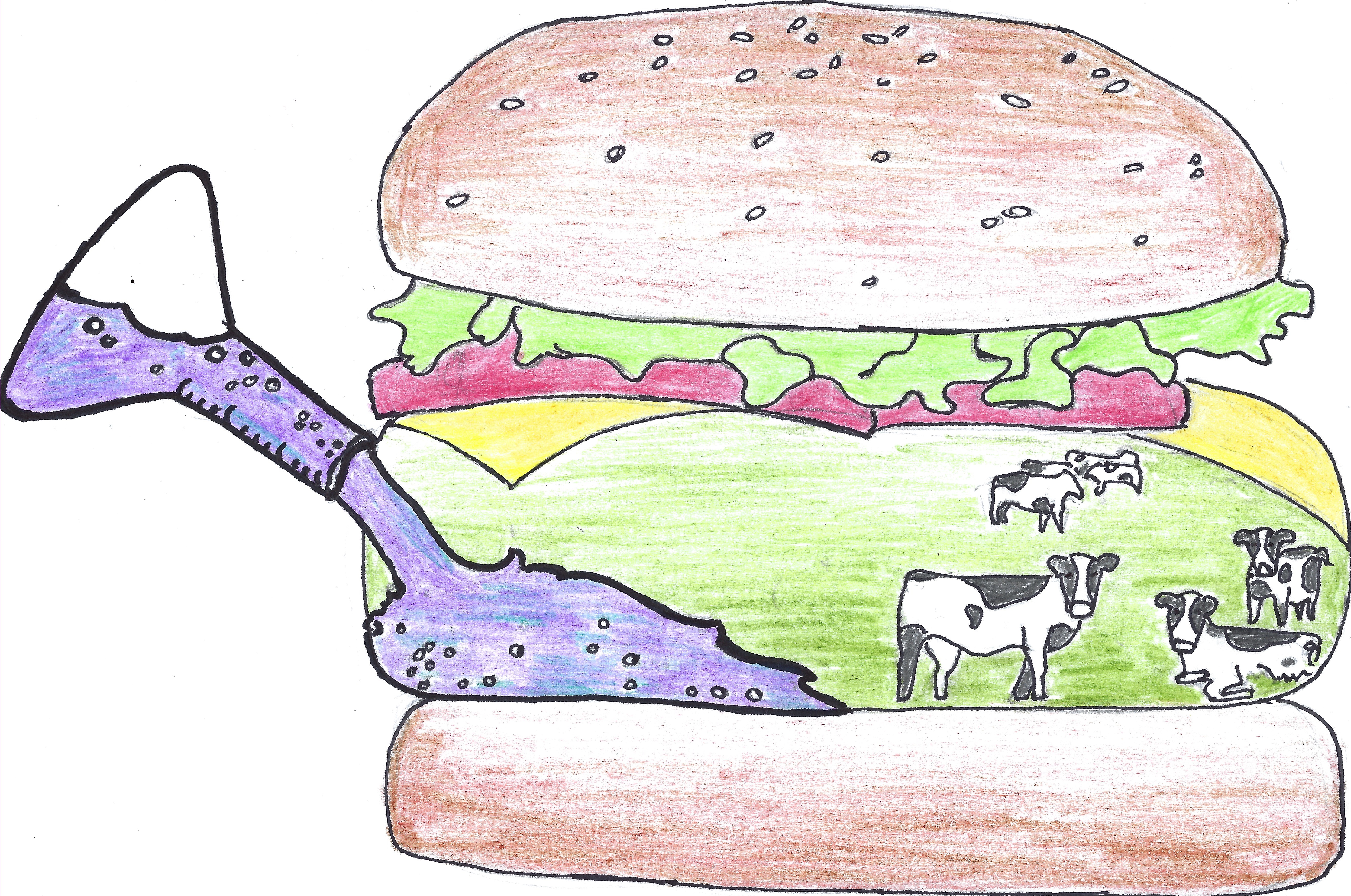Plant-based-faux-meats, which seek to mimic the singular flavor of animal products, are becoming increasingly prevalent throughout the United States. In recent months, alternative meat companies Beyond Meat and Impossible Burger, both of which are half food manufacturer and half tech startup, have been gaining traction. Fast food chains such as Burger King and KFC have unveiled products from both these two rapidly expanding brands with great success, inciting enthusiasm about the possible environmental and health implications of popular meat alternatives.
In stark contrast with your average black bean or garden burger, which are meant to replace, not mimic meat, these new fake meats are exactly that — fake meat. In addition to mirroring the levels of proteins, fats, and calories found in the real thing, these alternatives to animal sourced food seek to recreate the juicy texture and umami flavor of meat by extracting almost identical proteins from plants.
Plant-based-faux-meat should not be confused with cell-based-meat. The latter is grown in a laboratory from the muscle tissue of living animals and is not yet available to consumers.
It may seem strange to invest so much time and money into the seamless imitation of burgers and sausages when most vegetarians have never touched those foods. However, these products are not intended for herbivores. Instead, they target environmentally friendly, health-conscious omnivores.
Compared to other foods, the current techniques for raising and producing meat are extremely detrimental to the environment. A 2018 study published in The Journal of Science analyzed data from almost 40,000 farms in 119 countries. It found that one pound of beef is responsible for 1,050 pounds of greenhouse gases, while the same amount of tofu creates only 34 pounds. Furthermore, while livestock accounts for only 37% of protein and 18% of calories consumed by humans, it is responsible for 58% of greenhouse gasses emitted by worldwide agriculture. The study concluded that eating less meat is the single best thing an individual can do to combat climate change.
Health is another major factor when thinking about meat. A number of studies have found that red and processed meats are associated with an increased risk of cardiovascular disease, colorectal cancer and type 2 diabetes. Both the American Heart Association and the American Cancer Society have long recommended reducing consumption of these meats, but a study this year in the medical journal The Lancet found that North Americans still eat six times the recommended amount of meat.
It should be noted that the relationship between red meat consumption and health is under review. A paper, published in the October issue of the Annals of Internal Medicine, found no connection between meat consumption and diseases such as cancer and diabetes. The panel of scientists who conducted the study recommended that people “continue current processed meat consumption.”
Many experts have attacked this new study. Dr. Frank Hu, the chair of the nutrition department at the Harvard T.H. Chan School of Public Health, criticizes the study’s use of GRADE, a method of research designed for clinical drug trials. Hu says that this tool is not applicable to researching the health effects of food.
But whether or not meat is good for humans, it has been proven bad for the environment.
On their website homepage, Beyond Meat says their products are “better for you and the planet,” while Impossible Foods says that by eating their burgers, one can “save the best planet in the known universe.”
Both brands shamelessly advertise the healthy and sustainable nature of their products. But according to food experts, plant-based-faux-meat is not the all encompassing solution it is often made out to be.
The Impossible Burger gets its protein from soy and its fat from coconut and sunflower oil. It also uses soy leghemoglobin, a genetically modified and fermented yeast, to mimic heme, the molecule which gives meat its signature flavor.
The Beyond Burger, on the other hand, is gluten free, soy free and non GMO. Its protein comes primarily from peas, and it uses pomegranate and beet to achieve a red, meatlike color.
According to Consumer Reports, both these products share a similar nutritional profile to meat, and neither is actually more healthy than a normal beef burger. Although the meat alternatives contain less dietary cholesterol, they have much more sodium.
Furthermore, plant-based-faux-meats are highly processed. Neither the Impossible Foods or Beyond Meat companies fully disclose the processes involved in creating them. Kathleen Fazio, Director of Food Services at Lick, is skeptical of this fact, and says, “I don’t consider these plant based meats real food.”
Fazio’s concern is echoed by Sam Mogannam, owner of Bi-Rite Market and founder of the Bi-Rite Family of Businesses. Mogannam explains, “part of my anxiety with the Impossible Burger is the unknown long term impact on our health with leghemoglobin.”
Mogannam cites a study conducted by Impossible Foods itself, in which rats were fed leghemoglobin for 28 days and compared with rats on a normal diet. The company claims the study indicated “no risk of allergenicity or toxicity.”
However, as Mogannam points out, according to GMO science, the rats did develop “unexplained changes in weight gain, as well as changes in the blood that can indicate the onset of inflammation or kidney disease.” And Micheal Hansen, senior scientist at Consumer Reports, notes that “there are still no long term studies of soy leghemoglobin in humans.”
Nevertheless, Mogannam is confident that Impossible Foods will reformulate their burger, saying “the consumer will eventually understand it better, and will begin to demand change…I don’t think it will be long before Impossible [Burger] stops using genetically modified soy.”
Adriano Paganini is the CEO and founder of the Back of the House, a restaurant group responsible for a number of successful SF restaurants including Super Duper, Lolinda, and Unos Dos Tacos. On Friday, September 20, he opened Wildseed, a completely plant-based restaurant on Union Street. Although the Impossible Burger will be on the menu, Paganini says that the “point of the restaurant is to show that a meal without meat can be delicious.”
Paganini grew up in Italy on a Mediterranean diet, a style of eating characterized by a high consumption of vegetables and olive oil, and moderate consumption of protein. He is not a fan of the ultra processed nature of fake meats, and when asked about their future, he said “the trend that is here to stay for me is eating healthy food.” His advice: “a meal or two a week without meat, that’s one good way to start.”
Phil West, owner of three SF bars and former Michelin Star chef, points out that the upper end of fine dining has always been low on protein. “There’s only so much you can do with a nice piece of steak,” he says. “It’s really how do you show that off with other great vegetables.”
West says he has had a difficult relationship with plant-based-faux-meat. He used to serve the Beyond Burger at his Valencia St. bar, Beehive, but his supply of the product was pulled as Beyond Meat acquired new, more prominent customers such as KFC. West understands the decision, but is still frustrated. “It’s just a very typical tale,” he says. “They’re going to go with the big fish even though the only reason they got started was because of the little fish.”
West offers a different approach to sustainability in the restaurant business. He explains that rather than buying only select cuts of meat, “a lot of fine dining and even average restaurants are getting in literally a whole carcass. They can use the heart, they can use the bones for stock, they can render the fat, they can make sausage out of the tougher meat and make steaks out of the more tender meat.”
West acknowledges that it may seem counter intuitive, but by incorporating more animal parts into their food, he thinks the restaurant industry can reduce waste, and thereby lower their carbon footprint.
For the average consumer, who is not ordering entire animals, Paganini recommends that you “only order what you are going to eat.” He explains that Lolinda, his Argentinian restaurant, is one of the only steakhouses that encourages customers to share one portion. “If you eat meat, you don’t want to be wasting meat,” he says.
In spite of the unknown health risks associated with plant-based-faux-meat, it has received very positive reviews on its realistic taste. “It’s genius” says Mogannam, referring to the Impossible Burger. “They’re going to keep iterating and evolving,” he adds. “I wouldn’t be surprised if in ten years it was indiscernible.”
West explains that “everyone just thinks, ‘Oh, it’s a burger, it should be easy,’” but “it’s a little inside joke among chefs that it’s one of the harder things to do well and get right.”
Although Lick experimented with serving the Impossible Burger once during the 2018-2019 school year, it is unlikely that plant-based-faux-meat will return to the Caf any time soon. Fazio, who works to create healthy and delicious vegetarian options and doesn’t think imitation meat aligns with this mission. “I don’t really want my food produced in a laboratory,” she says.
Impossible Burgers and Beyond Burgers are also quite expensive, which can be a limiting factor. Yet even when fake meat inevitably becomes less costly than the real thing, Fazio says she would still be reluctant to serve it. “It would go against my principles,” Fazio says. She says a plant-centric diet, with more fruits and vegetables, is a better solution.
The jury is still out on whether or not fake meat and cell-based meat will render livestock completely obsolete, yet it looks as though meat alternatives will play a significant role in our future. On September 26, McDonald’s began testing a Beyond Meat patty in Canada, adding to the long list of fast food chains which carry some form of plant-based-faux-meat. The global consultancy ATKearney projects that by 2040, 60% of meat will be either cell or plant-based.
Most of the food experts interviewed for this article admit that they are unsure about the future of fake meat. They all were hesitant to embrace this unfamiliar blend of unpronounceable ingredients, sticking instead to what they know, and driving home the importance of fruits and veggies, responsible sourcing and waste reduction. But they are also part of a progressive culture in the Bay Area that works towards environmental sustainability and seeks to promote a healthy lifestyle.
Meanwhile, in states such as Arkansas, Mississippi, and Missouri, Big Beef has successfully lobbied for laws which ban the word “meat” on any products which do not come from live animals. In these areas, at the present time, plant-based-faux-meat may be the only realistic way to lower meat consumption.






